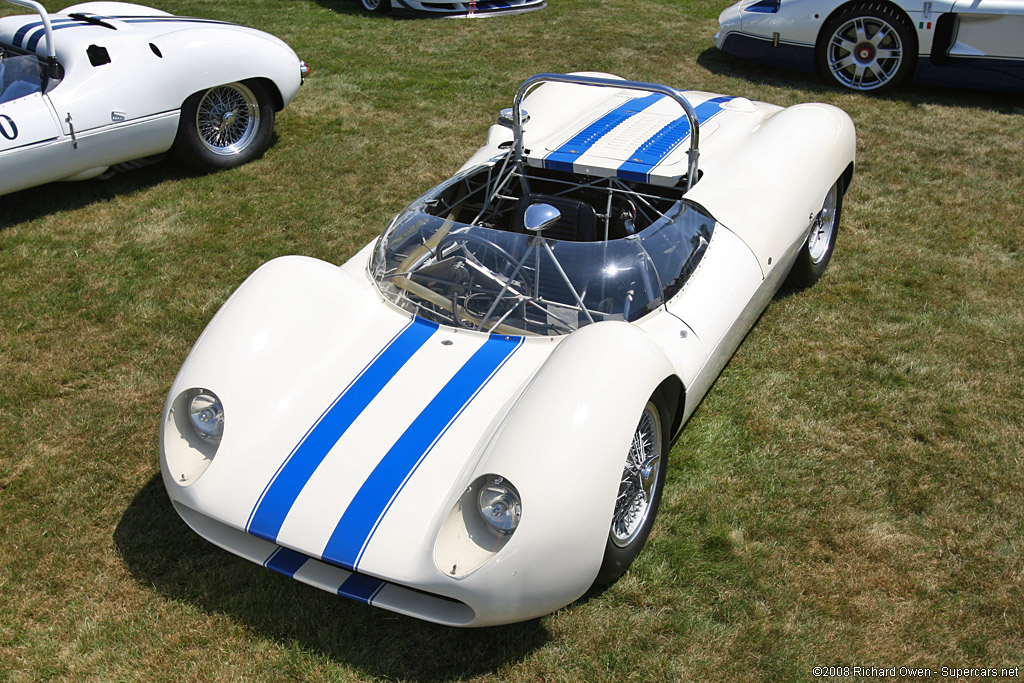1962 Maserati Tipo 64 Supercage
After a lackluster season spent developing a rear-engine sports car, Maserati pursued the design for another season with the Tipo 64 in 1962.
In theory, the new car was much like its processor, the Tipo 63. Both shared the same ‘birdcage’ principle for their chassis including a complex network of thin tubes to support the running gear and aluminum body. However, the Tipo 64 was much different in detail. The car was lighter, smaller and lower, mimicking the size of its direct competition, the Lotus 19.¹
For the Tipo 64, engineer Alifieri drafted an entirely new chassis that used much smaller diameter tubing than before. Furthermore the front and rear suspension were reconsidered. At the rear, a flexible de Dion suspension was installed and used a box shaped superstructure instead of a regular tube. This is probably is probably why journalists of the era called it the ‘Supercage’.
Weighing 95kg less that the outgoing Tipo 63, the Tipo 64 was on the right track. Furthermore the driver was pushed forward in the chassis which mended the terrible balance of the earlier cars.
Behind the driver sat an evolution of the V12 engine that was developed for the 1957 250F T2 in Formula 1. To endure the torture of a long distance race, drivers kept to 8500 rpm even though 10,000 rpm was used in F1. With a number of bore-stroke combinations available, the cars fluxuated in specification.
Two chassis were made for the 1962, the first prototype went to Lucky Casner’s Camoradi team while the second was sent to Count Volpi’s Scuderia Serenissima. The later of these had a special body styled by Franco Scaglione that featured a characteristic pointed nose.
1962 Racing.
Both Tipo 64s debuted at the Sebring 12 Hours in Florida. Unfortunately, both of these retired and set the standard for the rest of the season. Afterwards, Camoradi decided to restrict his car to US racing, while Count Volpi prepared his for the upcoming Targa Florio. Unfortunately, Volpi’s car failed to finish the Targa and he abandoned Maserati altogether.
For LeMans, engineer Alfieri abandoned his rear-engine concept. Instead he used a simple tube-frame chassis similar to the old 450S and fitted a powerful V8 engine in the front. Clothed in a dramatic coupe body, these Tipo 151s look promising but both retired. Alfieri was right, the overall winner was a front-engine Ferrari, but it was the last time a front-engine car would win Le Mans.
Cunningham continued with the Tipo 64 in various SCCA and Westcoast races but it almost always failed in retirement. This car ran alongside the Tipo 151s which must have made Maserati’s effort seem disorganized in 1962.
As a direct successor to the Tipo 64, a sole Tipo 65 was built in haste for 1963.
Story by Richard Owen
In Detail
| tags | birdcage |
| submitted by | admin |
| type | Racing Car |
| production | 2 |
| predeccesor | 1961 Maserati Tipo 63 |
| engine | Twin Spark V12 |
| fuel feed | 6DCV 35 Webers |
| displacement | 2997 cc / 182.89 in³ |
| bore | 68.8 mm / 2.7 in |
| stroke | 68 mm / 2.7 in |
| compression | 10:1 |
| power | 238.6 kw / 320 bhp @ 8200 rpm |
| specific output | 106.77 bhp per litre |
| bhp/weight | 470.59 bhp per tonne |
| front brakes | Girling Discs |
| rear brakes | Girling Discs |
| steering | Rack & Pinion |
| f suspension | Double Wishbones |
| r suspension | deDion Axle |
| curb weight | 680 kg / 1499.4 lbs |
| wheelbase | 2310 mm / 90.9 in |
| front track | 1250 mm / 49.2 in |
| rear track | 1200 mm / 47.2 in |
| transmission | 5-Speed Manual |
| top speed | ~300.88 kph / 187 mph |





